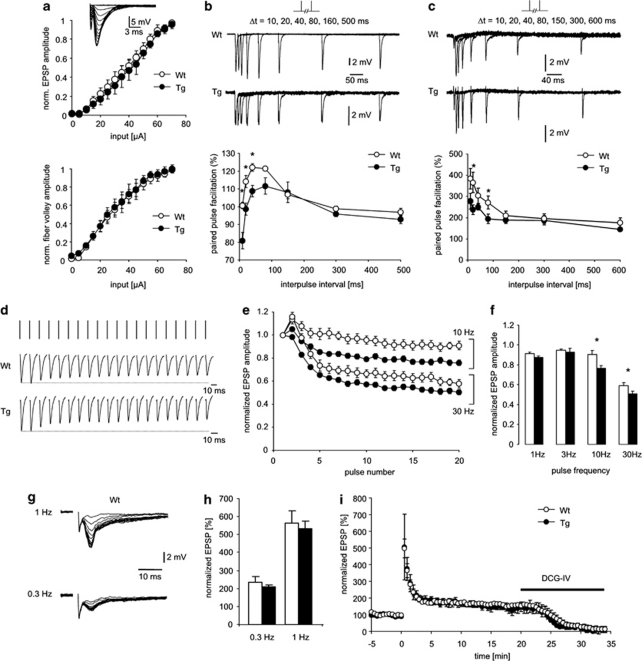Figure 2.
Altered synaptic transmission in G72Tg mice. (a) Basal synaptic transmission is unaltered. The dependence of the normalized excitatory postsynaptic potential (EPSP) magnitude on the stimulation strength was unchanged in G72Tg mice. Likewise, the dependence of the presynaptic fiber volley size on stimulation strength was unchanged. Insets depict representative examples of EPSPs recorded from G72 wild-type (Wt) and G72Tg mice. (b, c) Paired-pulse presynaptic plasticity at path-dentate granule (PP-DG) (b) and mossy fiber-CA3 (MF-CA3) (C) synapses. The paired-pulse facilitation for control and G72 transgenic mice (empty and filled symbols, respectively) was calculated as the peak amplitude ratio of the second to the first of two consecutively elicited EPSPs. Representative examples in top panels and quantification in lower panels. (d) Response of PP-DG synapses to sustained synaptic stimulation. EPSPs were induced by stimulus trains at varying frequencies (1–30 Hz). A representative example for a G72Tg and a Wt mouse is shown. (e, f) Progressive reduction of the EPSP magnitude during 10 or 30 Hz stimulus trains. Average EPSP amplitudes are plotted normalized to the amplitude of the first EPSP in the train (e). The depression of EPSPs was significantly more pronounced in G72Tg mice for stimulation frequencies of both 10 and 30 Hz (f). (g, h) Frequency facilitation at MF-CA3 synapses at frequencies of 0.3 and 1 Hz. A pronounced facilitation of MF-EPSPs in both Wt and G72Tg mice (g) did not significantly differ between these groups (h). (i) Potentiation of MF-EPSPs by a high-frequency stimulus train. Tetanization resulted in a pronounced post-tetanic potentiation with a subsequent decline to stable potentiated levels for both Wt and G72Tg mice (empty and filled symbols, respectively) with no differences between groups. All data are expressed as mean±SEM. *p<0.05.

